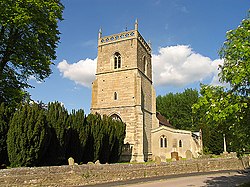East Hendred
| East Hendred | |
| Berkshire | |
|---|---|
 Church of St Augustine of Canterbury | |
| Location | |
| Grid reference: | SU4588 |
| Location: | 51°36’4"N, 1°18’14"W |
| Data | |
| Population: | 1,092 (2001) |
| Post town: | Didcot |
| Postcode: | OX12 |
| Dialling code: | 01235 |
| Local Government | |
| Council: | South Oxfordshire |
| Parliamentary constituency: |
Wantage |
| Website: | East Hendred |
East Hendred is a village in north-western Berkshire, about 4 miles east of Wantage and a similar distance west of Didcot.
The village lies in the Vale of White Horse watered by the East Hendred Brook, which flows through the parish having run down to the Vale from the Berkshire Downs and outside the village empties itself into a joining of three brooks whose waters flow on north to the Thames.
The western extremities of the Harwell Science and Innovation Campus are in the parish. The Ridgeway and the Icknield Way pass through the parish.
Parish church
The parish church of Saint Augustine of Canterbury dates from late in the twelfth century. It contains a rare working example of a sixteenth century faceless clock by John Seymour of Wantage, which as well as chiming and striking plays the Angel's Hymn by Orlando Gibbons every three hours.
The church has a perpendicular style square west tower, displaying the put-log holes of its construction.
David Cameron, current prime minister of the United Kingdom, married his wife Samantha at the church on 1 June 1996 - five years before he entered parliament and 14 years before becoming prime minister.[1]
History
By East Hendred is Scutchamer Knob where King Edwin of Northumbria is said to have killed Cwichelm of Wessex in the 7th century. Scutchamer Knob or Cuckhamsley Hill is the site of an Iron Age burial chamber, a long barrow, and was the meeting place of the Shire Moot in mediæval times. It is located on the Ridgeway National Trail at the southern end of the village.
The parish consists of five manors: King's Manor, Abbey Manor, Frampton's Manor, New College Manor and Arches Manor. Abbey Manor was a grange of Reading Abbey, while Hendred House is the manor house of Arches. Hendred House is today the home of the Eystons, the oldest family in old Berkshire to have continuously held the same manor. One of the local public houses is named after them.
There is a small museum in an old 15th century wayside chapel (Champs' Chapel).
Hendred House and the Eyston Family

The village is unusual in having a manor, Hendred House, which has been in the occupation of a single family for over six hundred years. The Eyston family first acquired the property in the mid-fifteenth century and remain lords of the manor to this day. The Eyston family were recusants who remained attached to the Church of Rome after the English Reformation, and this has had a strong influence on the history and development of the village. The mediæval chapel of Saint Amand, a private chapel attached to the manor house, continued to conduct Roman services throughout the penal times and is still used for occasional services today. The family was also responsible for the building of a Roman Catholic church in the village, St Mary's, and the establishment of St Amand's School during the nineteenth century,
Notable members of the Eyston family include Charles Eyston, a seventeenth century antiquarian, and Captain George Eyston, who held the world land speed record during the 1930s.
Nunnery
Adjoining the Roman Catholic church of St Mary is Holy Trinity Monastery, East Hendred, a community of contemplative Benedictine nuns, the first to be founded in this country for more than half a century.
Amenities

East Hendred has 3 public houses, The Wheatsheaf.,[2] Eyston Arms and The Plough. The Champs Chapel Museum of East Hendred houses artefacts, archives and photographs from the village's history. The collection of the museum can be viewed online.
See also
References
Sources and further reading
- Addenbrook, M (1971). East Hendred: a brief guide. The Hendreds Society.
- Gibson, D, ed (1982). A Parson in the Vale of White Horse: George Woodward's Letters from East Hendred 1753-1761. Alan Sutton Publishing.
- Manley, E.R. (1969). A Descriptive Account of East Hendred. privately published.
- Page, W.H.; Ditchfield, P.H., eds (1924). A History of the County of Berkshire, Volume 4. Victoria County History. pp. 294–302.
- Pevsner, Nikolaus (1966). Berkshire. The Buildings of England. Harmondsworth: Penguin Books. pp. 133–134.
Outside links
| ("Wikimedia Commons" has material about Hendred East Hendred) |
